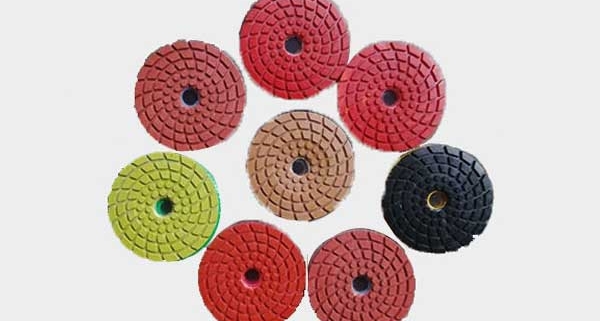After the resin material and the glue are stirred, they are in the form of liquid during the production operation. Unlike the polishing pad powder, it is easy to fly. The stirred powder is poured into the forming abrasive, and the mold is removed by a special fixture. Bake in an oven for 20 minutes, bake at a temperature of about 70, and cure.
Such a resin polishing pad is produced. The resin-bonded polishing pad is mainly used for grinding and polishing of various stone surfaces, and does not dye the stone. Excellent quality and reasonable price, it is an ideal dry grinding and polishing tool. So how do you use a resin polishing pad?
Resin polishing pad rough grinding treatment:
1. terrazzo floor, concrete colored sand floor, uniform dry sand hardening agent floor: according to the floor hardness, select the granularity 30#-200# concrete soft (dry) polishing pad and concrete polishing pad coarse grinding, using particle size 100# – 300#’s matching medium and large grinding machines can improve the grinding efficiency and make the ground flatness better.
2. After the ground leveling treatment, select the high-grain number (100#-300#) concrete polishing pad for rough grinding.
Resin polishing pad fine grinding treatment:
1. Ground after rough grinding: Generally, the fine grinding treatment using the above-mentioned particle size 300#-1500# is selected, and the matching medium and large grinding machine can be used to improve the grinding efficiency and make the ground flatness better.
2. Newly made aggregate hardener surface to maintain the surface effect of the original slurry: Select the above-mentioned granular floor soft polishing pad of 300#-500# or a small-sized grinding machine, and select the corresponding size number according to the surface hardness and curing time of the floor. Polishing pad. A new floor with good mechanical light is easy to make a uniform surface effect.
In addition, pay attention to the use of the resin polishing pad:
1. When working, the workpiece should be fixed, the profile positioning should conform to the direction of the knife to avoid abnormal cutting, do not apply side pressure or curve cutting, the feed should be smooth, avoid the blade impact contact with the workpiece, resulting in damage, or workpiece flying. Out, an accident occurred.
2. When working, if the sound and vibration are abnormal, the cutting surface is rough, or the odor is generated, the operation must be terminated immediately, and the fault should be checked in time to eliminate the accident to avoid accidents.
3. When starting cutting and stopping cutting, do not feed the knife too fast to avoid broken teeth and damage.
4. If cutting aluminum alloy or other metals, use a special cooling lubricant to prevent overheating, paste, and other damage, affecting the quality of the cut.
5. Equipment chip flute and slag suction device ensure smooth flow to prevent slag from forming into blocks, affecting production and safety.
6. When dry cutting, do not cut continuously for a long time, so as not to affect the service life and cutting effect of the polishing pad. Wet film cutting should be cut with water to prevent leakage.




